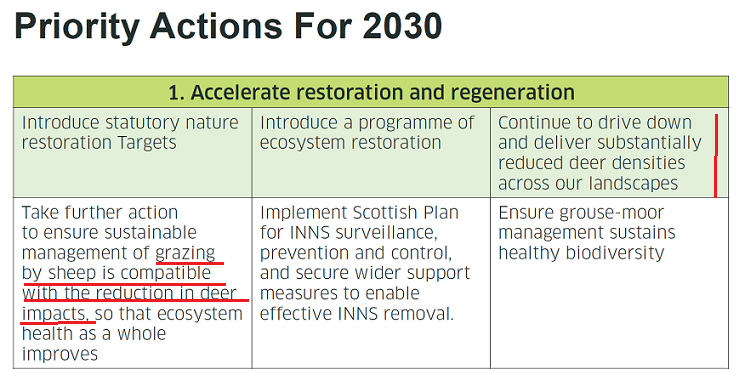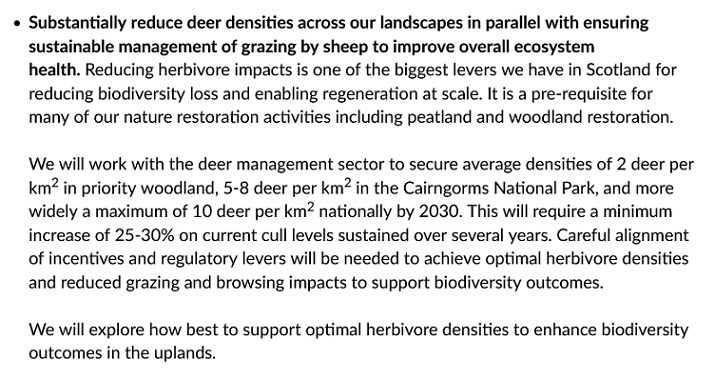
The Scottish Government’s consultation on “Tackling the Nature Emergency: Scotland’s Strategic Framework for Biodiversity” (see here), which was launched in September and includes proposals to reform Scotland’s National Parks, closes on 14th December.
To date I have only considered the Scottish Government’s undemocratic proposal to increase Ministerial control over appointments to National Park board appointments (see here). Here I consider the Scottish Government’s proposals for reducing deer numbers.
Judging by her public pronouncements (see here) Lorna Slater, the Minister responsible for National Parks and biodiversity, does seem to understand that overgrazing by deer is the biggest single reason for the collapse of nature in Scotland over the last thirty years. The problem, however, is the proposals in the consultation fail to address the system failures identified in the report of the Deer Working Group (see here) and set targets which, although a step forward, are still unfit for purpose:

The positive element of this proposal is the recognition that deer density should be no more than 2 per square kilometre in “priority woodland”.
While twenty years ago the general position was that deer densities of 10 per square kilometre were necessary to avoid ecological damage, work by Wildland Ltd and the National Trust for Scotland at Mar Lodge has shown is there is no significant regeneration of native pinewoods unless deer numbers are reduced to two per square kilometre. That is now partially recognised by government, not just in the consultation but by bodies such as Forest and Land Scotland (see here) who state deer densities should be between 2 – 7 in woodland (compared to the 4 – 64 per square km currently found on their properties).
The questions for the Scottish Government, however, are:
- why two deer per square km only in “priority woodland”, which doesn’t seem to be defined in the draft strategy, and why not across all woodland which would enable us to get rid of all forest fencing and plastic tree tubes?
- and why not for other priority habitats to enable other vegetation (such as moorland or summit heath) and not just trees to regenerate?
The proposed average deer density for the Cairngorms, 5-8 per square kilometre, is taken from the Cairngorms National Park Authority (CNPA) Partnership Plan adopted last year. It is not fit for purpose. With deer numbers in much of the Cairngorms Connect area and the restoration zone of Mar Lodge Estate at 2 per km, and even less in parts of the Angus glens and on King Charles’ Delnadamph estate – where deer have been to all intents eradicated in favour of red grouse – this is a license for other landowners in the National Park to maintain deer at well over 10 per square kilometre.
If we are serious about nature restoration deer should, as a start, be reduced to 2 per square kilometre across all of Scotland’s protected areas. Strangely, the consultation makes no mention of Scotland’s other National Park where deer currently cause massive problems. The Loch Lomond and Trossachs National Park Authority (LLTNPA)’s proposals for deer have just been published in their new National Park Partnership Plan which is to be considered at their board meeting on Monday (see here). Among their “measures of success” – no date is given for this “target” – are:
“Track completion of Herbivore Impact Assessments for all Deer Management Groups and measure average deer densities. Achieve nationally recognised target levels of average deer densities – currently a maximum of 5 deer per km2 in woodland and a maximum of 10 deer per km2 on the open hill”
This target is even less ambitious than that for the Cairngorms and doesn’t even mention the “priority woodland” targets included in the Scottish Government’s consultation. That is despite the many examples of moribund “Atlantic Rainforest” oak woods in the National Park and the history of failed attempts to restore the Caledonian pinewood remnants to good ecological condition. This is a National Park Authority incapable of taking a lead and in need of radical reform.
While the targets set out in the Scottish Government’s Strategy are unfit for purpose, they are also bound to fail because there are no proposals to change the voluntary system of deer management in the consultation. That voluntary system is once again falling apart with Deer Management Group (DMG)’s failing to publish up to date information on deer numbers or actions that have been agreed at meetings etc.
Here is an example from the Inverary and Tyndrum DMG, part of which is the Loch Lomond and Trossachs National Park and includes the Strone Estate. This is owned by Tom Turnbull (see here) who is chair of the Association of Deer Management Groups and so you might expect it to exhibit best practice:

Instead of reforming this failed system and committing to concrete actions, the diodiversity strategy commits the Scottish Government to “explore how best to support optimal herbivore densities in Scotland to enhance biodiversity outcomes in the uplands”. The commitment to “explore” is not good enough in a nature emergency and a recipe for years more inaction.
There are at least four actions the Scottish Government could commit to immediately if there was the political will which would have an immediate impact on deer numbers:
1) Make all public subsidies, whether for agriculture, peatland restoration, nature restoration or tree planting dependant on landowners showing they are both committed to reducing deer to 2 per square kilometre in protected areas and four elsewhere and evidencing that they are taking appropriate actions to achieve this;
2) Redirect existing subsidies for deer fencing and plastic tree tubes to employing stalkers and reducing deer to 2 per square kilometre and focus subsidies for planting in the uplands to slopes where landslips threaten human infrastructure
3) Implement the changes to the shooting seasons recommended by the Deer Working Group. While the Deer (Close Seasons) Amendment Order came into effect on 21st October 2023, it only changed the season for stags, not hinds (see here for a very interesting commentary on the serious limitations to the order by a stalker). If deer numbers are to be reduced we need to extend the period that hinds, whose numbers determine the overall population, can be culled.
4) Instruct NatureScot to use their intervention powers to the full to achieve (new) target levels and, if that is challenged in the courts, strengthen those powers.
There are other measures which would help reduce deer numbers, such a Carbon Emissions Land Tax (see here), but these would take longer to implement and are for the medium-term rather than the short-term.
Unfortunately, there are no proposals for legislative change in respect to red deer included in the consultation. This is a wasted opportunity but also an indication of how the Scottish Government is in thrall to traditional sporting estates whose raison d’etre is to keep deer and grouse numbers artificially high. The challenge for Lorna Slater is to change that and turn her fine words into actions.

Some good ideas here. A major hindrance to the jncentives/cross compliance approach is that 50% of landowners are not interested in these incentives. They are super wealthy and want to shoot deer when they visit. . The management aim on the ground is therefore to keep numbers high . You cannot have a landscape scale approach to deer unless those 50% come on side. The only wat to do this is to introduce legislation that requires them to reduce deer densities.
Totally agree with your comments. We live just outside the CNP but have a serious deer problem in agricultural fields. The overall density in the region is claimed to be 8/km2 but when you have up to 150 in your fields at night that becomes somewhat irrelevant. In trying to get to grips with the problem we have found the local DMG to be totally ineffective,most landowners uninterested and some downright obstructive. It is immensely frustrating when the route to solving the problem is relatively straightforward but without strong legislation deer numbers are going to stay too high in the majority of the hills and uplands.
Red deer are never static populations…they are migrant ! I wish more peer-group appointed experts, instead of pontificating almost endlessly about density on a small area would get to grips with this problem for agriculture and really wake up.
The other night, as the heavy frost period began to ease thanks to a NE wind, I walked down the croft field after dark.
In the light of my head-torch four distinct masses of eyes were reflected. Each group moved off in sudden panic, most hopping over fencelines which others only crashed into in the dark. These beast were clearly not familiar with the alignment of fences?
There would have been over 20 red deer grazing this 2 acre field as I approached (A professional autumn cull of stags took out a large % of those summertime pests, so numerous through this year that plans for haylage had to be abandoned – the grass never high enough. ..now hinds are taking full advantage of un-harvested grasses across this same patch of low ground and at this season may not now be culled? )